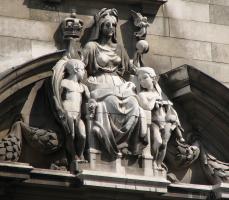
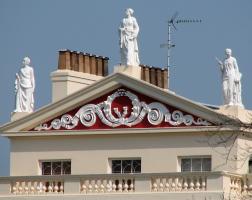
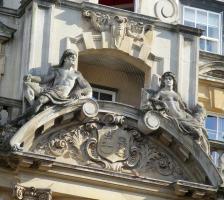
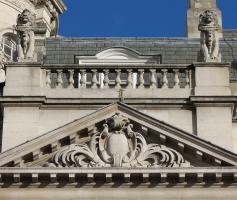
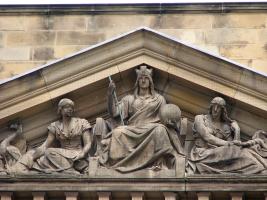
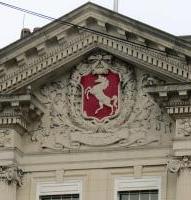
Surely of all the ways in which sculpture can adorn a building, the Classical pediment is the most grand and noble. The British Museum can perhaps lay claim to be the grandest portico in England, surely the most photographed one, and its sculpture occupied two decades of the life of the sculptor, Sir Richard Westmacott, as his last and perhaps greatest work of sculpture. The British Museum pediment has thirteen full size figures in all, Classical of course, and shows from left to right the Progress of Civilisation. Despite this left to right reading, the composition is fairly symmetrical, with the central figure of Civilisation balanced by an equal weighting of six figures to left and right, in ones and twos gracefully arranged. The background is left plain near the centre, to emphasise the central standing figure and her companions, and becomes busier towards the sides, with the tail of a flat turtle and the long nose of a proto-crocodile poking far into the narrow outer corners. Lots more on this noble sculptural composition on this page.
The British Museum pediment, by Sir Richard Westmacott, RA.
A pediment at its simplest is a low triangle with a protruding edging or ‘roof’ which rests on an entablature – a horizontal line of mouldings and a frieze – which is supported upon pillars. The proportions of the pediment, entablature and pillars are fairly restricted in pure Classical architecture, as documented by various Renaissance architects starting with Vetruvius, popularised by Palladio in his four books of architecture, and picked up with enthusiasm in Britain, first by Inigo Jones, then in the English Classical Baroque led by Christopher Wren and his disciples such as Nicholas Hawksmoor, then in the 18th Century the purer and more Greek Classicism of James Stuart, Robert Adam, James Wyatt, and George Dance the Elder. John Soane took neo-Classicism to 1837, when he died in the year Queen Victoria came to the throne, and so provides the bridge to Victorian Classical architecture, and among his varied and successful students, for a short while, was Robert Smirke, who designed the British Museum whose pediment we have been admiring.
Simple pediments, with space-filling sculptural adornment around a central feature.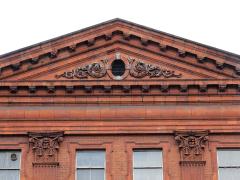
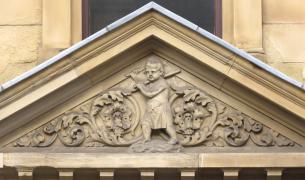
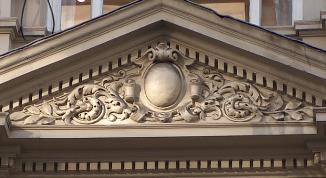
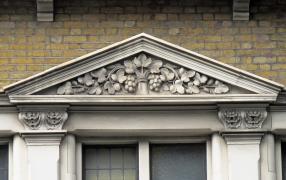
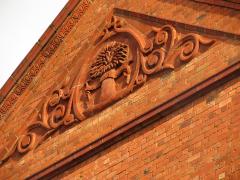
But let us start at the other end of the scale, back with our small and simple pediment, which we might find for example on a broad window, with the stone piers acting as the supporting pillars. Often, there is a simple space-filling treatment of relief sculpture. From left above, we have a terra cotta pediment with stylised floral decoration (Acanthus) flanking a window; then similar scrolly leaves around a boy, and a composition with similar Acanthus swirls around a central egg-shaped ball. The fourth example shows a symmetrical composition of a grapevine, very neat, very clearly delineated, and that on the far right is another terra cotta example with scrolling around a sheaf of corn.
A single, central decorative motif is also not uncommon. Below, we have from the left a rather spare pair of leafy shoots around a central window; a similar motif but somewhat more complex - you will need to click to enlarge to see ths properly; and in the centre, a small pediment over a portico containing a wreath and a winged cherub head, in pink terra cotta (there is a page on cherub sculpture here). Then to the right, a rather elegant small pediment, Baroque of course, with a shell motif overlapping the edges, most visually effective. And the last one has a central roundel bearing the arms of the City of London, and then long carved wreaths to either side, to avoid leaving the rest of the pediment blank.
Pediment sculpture where there is a single, central motif.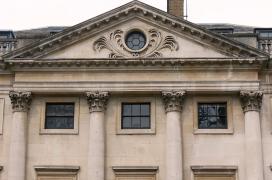
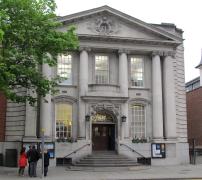
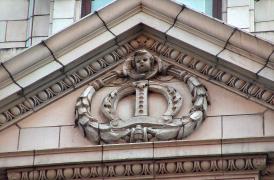
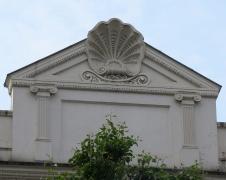
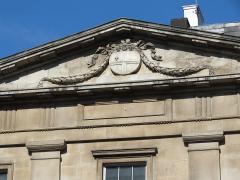
Following on from the idea of a central motif, the triangle of a pediment naturally fits a circle or roundel in the centre, and this can be the main feature of a pediment. Below we have a group of such. Firstly on the left, a Robert Adam stucco roundel with Classical figures in low relief. Then a nice example from the Vestry Room of St Martin in the Fields, by Trafalgar Square, with a roundel as large as possible and enclosing a scene of St Martin and the Beggar, this known to be by the sculptor William Pitts and dating from 1831. The third picture along is an oval rather than a roundel, which I chose as an example where the central shape is combined with subsidiary relief patterning to fill the rest of the pediment It is in the town of Tenby in Wales. The fourth example below on the far right has a large but simple pediment with a roundel showing a carved flower, being one of the minor faces of St Paul’s Cathedral.
Sticking with our central feature, if the pediment is a small one, we can have a sculpted head in place of the roundel, or indeed a roundel with a head inside it. The central pediment below is a rather splendid one, not that small actually, and shows a profile portrait of a Classical Greek girl in high relief, with a snake sipping from a small dish, in the centre; she is flanked by two alarmingly busty sphinxes (lots more sphinx sculpture on this page). To the left of this is a forward-facing head of Mercury or Hermes, messenger of the Gods, with his winged helmet; the rest of this little pediment above a window is filled out with a highly-undercut carving of wavy ribbons. To the right, on a curved pediment (more of these lower down the page), we have a head of some allegorical female, again forward-facing, within a wreath. On this large pediment, there is plenty of room to the sides for emblems of manufacturing and science on the left, and the arts on the right - there are also two perching owls, for this pediment is on the Leeds Institute, for which that bird is symbol. Smaller pediments with heads are particularly a feature of terra cotta buildings, and the two flanking pictures below show examples of these - a charmingly lively little head of a cherub on the left, and an ornate one with two companion heads within an open pediment to the right. Both are excellently conceived and the work of consumate modellers.
Pediments with carved heads as the central feature.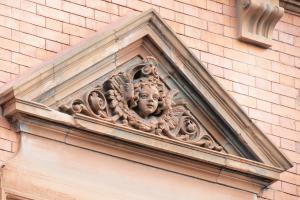
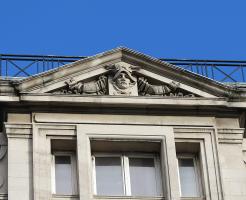
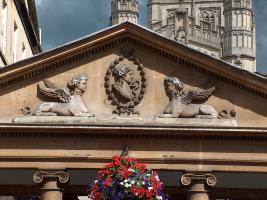
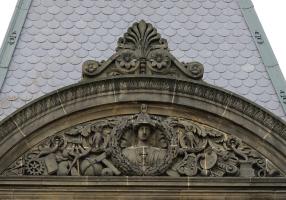
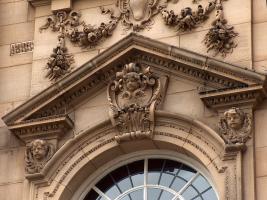
I think a natural next step from these pediments with central features, is to pediments containing heraldic decoration: a central shield of arms, or a roundel with the arms carved upon them, often with supporters to the sides. One of the more grand of these is below left, the Royal insignia with lion and unicorn supporters above the noble portico of St Martin in the Fields, Trafalgar Square, which we met above in its Vestry Room pediment. The next example has the Royal coat of arms broadened, to occupy rather more of the pediment - a really vigorously carved group, this one. The center picture below has as supporters a old man and a young girl, their backs to the central shield of arms, the feet out into the narrow corners of the pediment, another example of what can be done with terra cotta. Next, on a very large portico six pillars wide, with the outer ones coupled (paired), we have once again a central motif pediment, with two figures in a roundel and little shields of arms above them. If you click to enlarge, you can see the lion heads with little rings in their jaws lower down on the facade. The picture to the far right below really does want clicking on, as next to the central shield of arms, in place of supporters we have dead game birds and a rabbit, for this is one of the entrances to Leadenhall Market in London.
Heraldic pediments, with coats of arms and heraldic shields.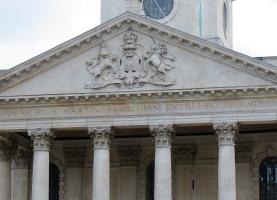
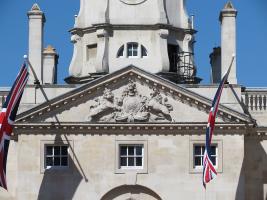
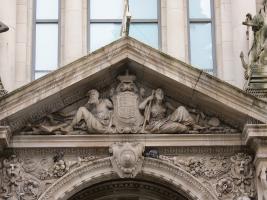
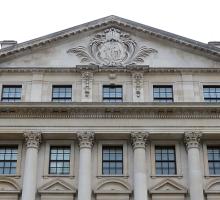
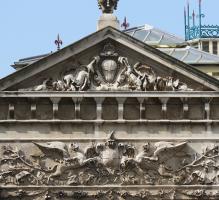
There are many examples of heraldic pediments across England. Here are a few more, all of heroic scale. The one on the left below is Guy's Hospital, off Borough High Street in South London, which is not heraldic but uses the heraldic composition exactly as for the central picture above: two supporters, reclining, on either side of the central motif. The second, the County Sessions House in Liverpool, has a central coat of arms with outward-facing dogs in the centre of the pediment, and the third, another hospital, has the Royal arms in a pediment above windows, treated portico style. Next, the Royal arms with festoons and cornucopias of flowers rather than supporters, and to the far right, rather obliquely in this picture, a four-column pediment bearing a painted shield or cartouche of arms with trailing festoons of flowers.
Heraldic pediments of large buildings.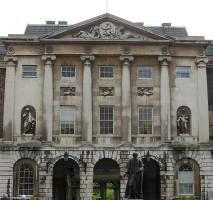
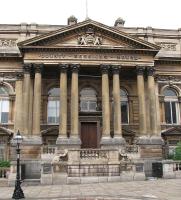
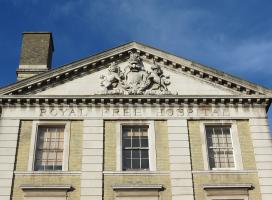
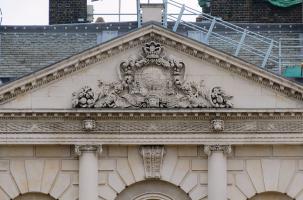
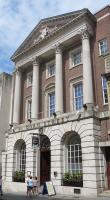
We started this page with the British Museum pediment, and now pick up pediments with figure sculpture, the noblest of all pediments, the most sculptural treatment, the closest to the temples of Ancient Greece from where the pediment ultimately derives. We start with one of the longest and most visually impressive pediments of them all, that to Cumberland Terrace, the largest of the Nash Terraces around Regents Park in London. The sculpture is by James Bubb, not the most well-known of sculptors, but by virtue of this ensemble alone, deserves far more recognition that he gets. If we count just the heads in this pediment, there are nearly 40, though some are small and a few have almost no body in view. The use of relief, picked out against a blue background, and separation between the various groups, gives the whole the contrast needed to see from some considerable distance.
Nash Terraces Cumberland Terrace pediment, sculpture by James Bubb.
Let us look at some more examples. The two central pediments below have refined Classical sculpture. That to the left has a group of two figures, a soldier and a figure of Fame with her trumpet. The pair form a broad pyramidal group in the centre of the pediment, with the narrow corners left blank, and further ornament provided outside the pediment by the pots to the sides and the entablature of bull skulls linked by festoons alternating with faces in roundels below. That to the right is another pyramidal composition, with a woman seated on a low plinth accompanied by male and female attendants. On the far left, rather oblique in this picture within a narrow street, is a Biblical scene, being the Good Samaritan, an example, not so common, of a non-symmetrical figure grouping within a pediment. And the example to the far right below shows a pediment open at the base, to allow for three larger, taller figures than would be accommodated in a normal pediment.
Pediments with figure sculpture, several figures.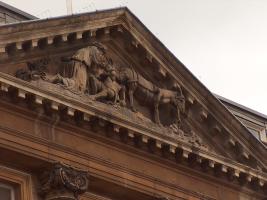
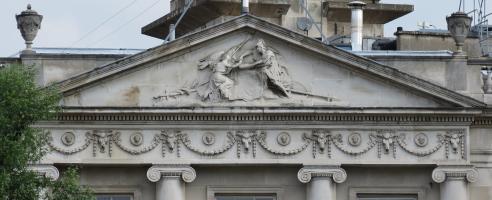
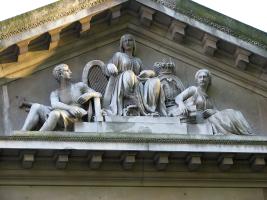
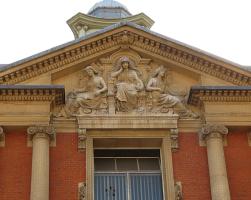
Here are three of the more spectacular pediments, the first being that on the river frontage of Somerset House in London. A river goddess is seated on a pair of finny sea-horses, with desporting cherubs and tritons accompanying her, against a background of sea life. Carved in relief, the composition is delicate and light, emphasised by the thin outer rim to the pediment; William Chambers was the architect of this frontage.
Somerset House pediment with relief sculpture.
Next, we have the pediment of the Royal Exchange in the City of London. We have 17 figures in all, and like the British Museum pediment, they are in small groups of two or three persons, and arranged around a central, raised figure, here being Commerce of course. Also as for the British Museum, we see smaller, flatter bits of sculpture going far into the narrow corners of the pediment - here tools and pots rather than animals. The sculptor was the younger Westmacott, son of the sculptor of the British Museum pediment.
Pediment of the Royal Exchange, City of London, by Richard Westmacott the Younger.
Our third example is something rather different: the Harrods pediment, grand and catching the light beautifully, but visible at such an oblique angle that it is difficult to see properly from ground level. Although Classical, rather than in cool white marble, the pediment is in warm red terra cotta, giving an entirely different mood. But the composition is again a symmetrical disposition of figures - cherubs in this case - around a central group of a seated Britannia with two female attendants. Being terra cotta, and so more weather resistant than marble, the figures can lean quite far out from under the slanting frame edges above. The sculptor was John Broad, working for Doulton's of Lambeth.
Harrods pediment in terra cotta, modelled by John Broad.
Next, let us look at some pediments where there are figure statues on top instead of within them. We have already seen the Cumberland Terrace example, with relief figures inside the pediment and statues on top of it, and below, second from right, is another one of the Nash terraces, with a slighter pediment of grotesques (figures altered to the point of being almost purely decorative), and above this essentially Renaissance design, we have three substantial summit statues of Classical girls as the main sculpture. The central picture below has a plainer pediment, with window and foliage as we have seen near the top of the page, with three figures and two slender-footed pots on top, giving a fine and varied skyline. Tate Britain is to the left of that, with central Britannia and two lions above a tall portico with spandrel sculpture lower down. The outermost pictures below show variations on the theme: to the far left, a statue of Apollo perhaps, above a busy and vaguely nautical scene within the pediment; and to the far right, a trisected pediment with relief cherubs, and stepped pots and a central statue of a woman above - surely this is the best silhouette against the sky.
If the pediment is small, such as over an entrance or even a window, then an alternative to the standing-figure-on-top presents itself, which is to use the slanting sides of the pediment as bases for reclining figures. This most attractive composition is widespread across the country. Below left, a couple, male and female, representing Agriculture and Industry, Victorian-Greek style. The semi-nude figures allow us to appreciate the torsos and arms; her musculature matches if not exceeds his. Their poses are with bodies facing forwards, legs outwards and seated on the sides of the pediment, and faces turning inwards to give a nice twist to each body. Next along, by contrast, a pair of semi-nude girls of more feminine build, reclining rather than sitting, Roman fashion. They look more or less forward and downward, bodies forward-facing again, and with a graceful and more subtle twist to the legs. The central group has a pair of infants for a change, their short legs meaning they have to sit rather than recline; like the previous example, their inside elbows rest on the central feature. Next a couple of Art Deco nude figures, awkward in aspect and pose, as you will see if you try and put your arm in that position. They are interesting in that they are kneeling, and are placed above rather than on the pediment sides. And to the far right below, we have another pair of nudes, male and female this time, far down the sides enough to dangle one leg each over the corner.
Pediment sculpture reclining on the slanting sides.
Of the pediments we have looked at so far, almost all have been triangular, with just a couple of curved ones. But curved pediments in the form of a shallow segment of a circle are rather frequent on the smaller scale, because the curved or segmental pediment works so well as an element of Classical Baroque architecture, as opposed to the coolness of proper Classical Greek or Roman. Christopher Wren laid down the type in English Classical Baroque, as in the picture below of Temple Bar, now emplaced just to the north of St Paul's Cathedral. The picture shows how a Baroque pediment can be nicely combined with other sculptural elements, including statues in niches, scrolls on the outside, and terminal griffins, a keystone and a winged wreath. If you click to enlarge, you will see that the curved pediment bears relief sculpture of a table or altar with two cornucopias to the sides - you can also see that the photo caught by chance a young couple meeting in rendezvous underneath.
Christopher Wren's Baroque, curved pediment on the Temple Bar.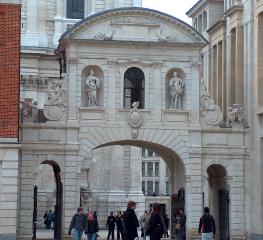
With the work of our greatest architect as a model, then, we can proceed to some simple curved pediments of Victorian and Edwardian times. Here are three. To the left, a shell-like Acanthus leaf composition. In the centre, more Acanthus around a harp, completely undercut. And to the right, a shallow curved pediment with a leafy branch and a central bird.
Curved pediments, also called segmental pediments.
Swan-necked pediments are more Baroque still - the curved pediment is broken in the centre, and rolled up, with the angular edges either left in a simple curve or given an S-shaped curve - the swan neck. Of the pictures below, that to the left is in Bridge Street, Manchester, which has a page of its own. The second picture shows two coiled sides linked by a short festoon. The third has a face within a swan-necked pediment. And the fourth has a nice little pair of angels, and extremely refined pots in the centre and at the sides.
Swan-necked pediments, with minor sculptural decoration.
On to more complex curved pediments. Here is our type specimen, with a central motif of three winged cherub heads, and a splendid pair of nude figures reclining on top, holding a central frame. Unusually for figures on top of pediments, each has a knee stretched forwards, the other leg on top, thus the lower body facing forward; the upper body turns inward, so the arms can grasp the frame, and then the heads are forward and downward, thus with a central twist to each body, and a sense of dynamic movement as if in flight rather than reclining.
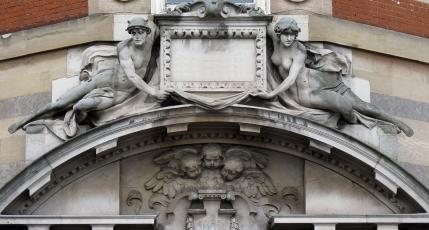 Curved pediment with figures and cherub heads.
Curved pediment with figures and cherub heads.
Some more examples of curved pediments with figures are below. To the left, a charming group of two girls with an infant, with carved thistles to either side to fill out the pediment. Then the doorway of the Old Bailey, with its three allegorical female figures seated on top of the curved pediment. Next, seated cherubs around a central cartouche, with a horn of plenty and a nautical scene - full grown figures would have been too tall here for the scale. The fourth picture shows a heraldic composition with children as supporters, and again a space-filling treatment of the pediment. And the fifth is a long pediment with an Adoration of the Shepherds scene with the figures well spaced - their smaller size gives a large space to the pediment.
Curved pediments with figure sculpture.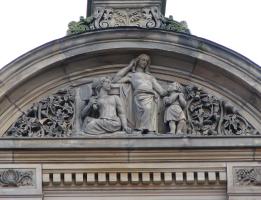
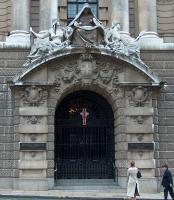
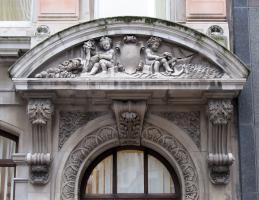
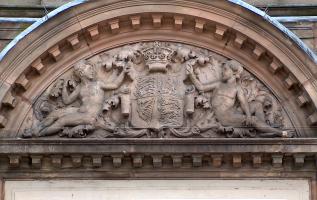
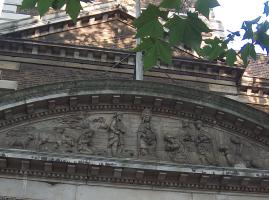
Curved pediments seem to lend themselves well to being broken at the top, that is to say, with the central part missing, another fashion of the Classical Baroque.A pediment is usually described as a ‘broken pediment’ if it has the top missing, but if the straight base is partly or entirely missing, then it is an ‘open pediment’ - though a few authors use exactly the opposite terminology, and many people use the terms interchangeably. The picture below left is an Art Deco pediment with an Atlas figure. Central is a Phoenix rising from the flames, its head in front of the broken area of the pediment. The third example has two figures, quite weatherbeaten, looking towards the central gap between them.
Broken curved pediments with figure sculpture.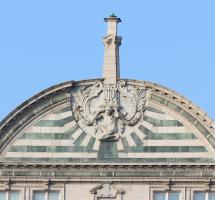
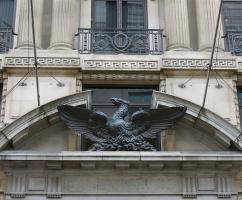 <
<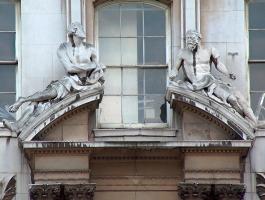
Open pediments now, which are open at the base, to give a deeper field for sculpture than the narrowness of a properly proportioned pediment. These examples are all above windows, so quite small. That to the far left below is really quite minimal, being a roof above a cartouche and crossed branches. Next, a fine masculine head with crossed weapons behind. The central head is a very young-looking Athena with her helmet, and the fourth is another female with styled hair. The right-most one, rather androgynous, is surrounded by abstract loops to fill the pediment.
Open pediments above windows, with carved heads.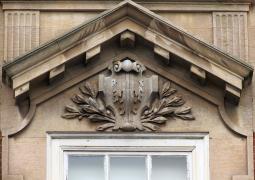
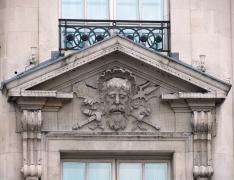
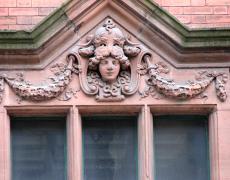
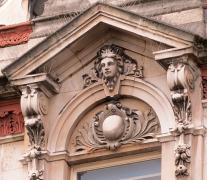
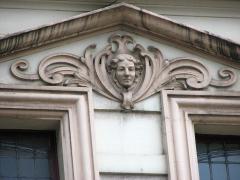
And larger examples of open pediments. Below left is a broken and open pediment, with a cartouche and flaming torches within it. Next, a pair of winged cherubic figures, perhaps mer-boys, or grotesques, and the carved head of a satyr on top. The next one has a large cartouche and crossed weapons protruding below the base of the pediment, and a figure on top. Then a strange composition, with a pediment far too small to contain the three nude figures within it, man, woman and child. The fifth pediment along is a large one, entirely open at the base, and showing a sea battle - it is on the front of Deptford Town Hall. To the far right is a view of part of Victoria Station in London, with the pediment open at the base, and with the centre top part raised, above curled sides, on which sit Edwardian Baroque semi-nude figures.
More ornate sculpture on open pediments.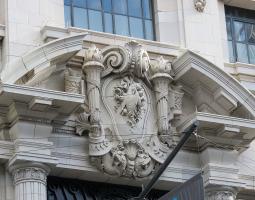
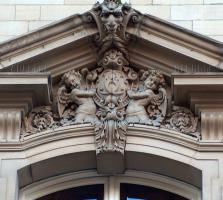
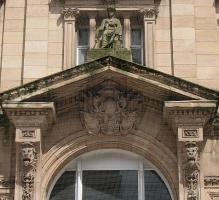
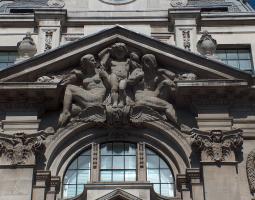
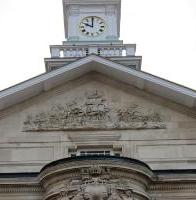
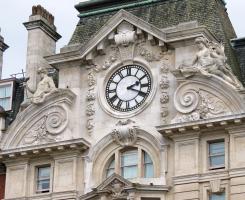
Here is an important mosaic pediment, from the courtyard of the Victoria and Albert Museum – the composition could as easily been for sculpture.
Victoria and Albert Museum courtyard pediment with mosaic.
This V&A pediment leads us into a few unusual examples, all rather small, and above windows. Below left, a pediment shape above a window, with strapwork and no edge at all. Then a very flat pediment, again above a window. And to the right is the opposite case, where the triangle is too tall for its breadth, in this case accommodating a medieval-style half-lizard half bird. The two below right are both terra cotta: firstly a head within a highly segmented pediment, coming forward and both upward and downward across the frame of the pediment; and lastly a pediment in two parts: a lower, swan-necked pediment and an upper triangular one. A mix of motifs, and although above a window, we see coupled columns on each side.
Unusual small window pediments.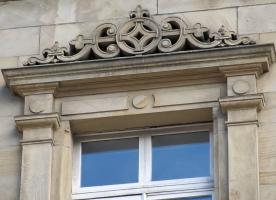
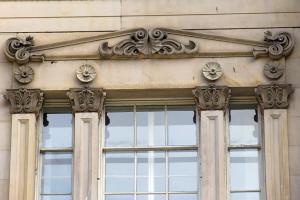
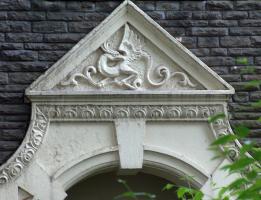
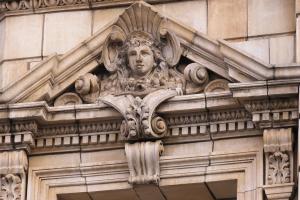
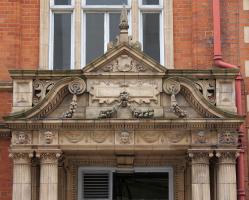
We think of pediments as being completely associated with Classical buildings, but these last few show how far we can stretch the pediment idea to different purposes, and for the High and Late Victorian buildings, of great inventiveness, which need such a thing, we can imagine what a Gothic pediment could be. Thus if we take the triangular pediment shape and make it to a tall triangle, then this is what we get. Below left, a busy medievalised scene modelled in relief, with a king on his throne, ecclesiastics with crucifixes, and knights. The triangle is divided horizontally to give space to a shield of arms above. In the centre, a seated bishop in a tall 'pediment', divided vertically into trefoil-headed niches, with a seated bishop in the centre; note the crocketing on the edging. And to the right, a splendid 19th Century griffin, semi-heraldic and utterly medieval in spirit.
Gothic 'pediments' of triangular form.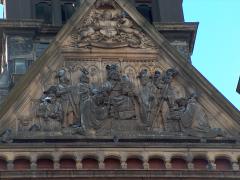
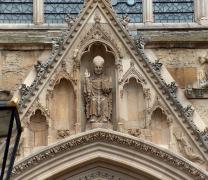
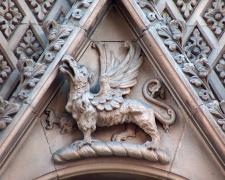
So much for these diversions from pure Classical, to Classical Baroque, through curved and swan-necked pediments, open and broken pediments, and oddities of terra cotta and stone. Here to end is a return to a purer Classical, a Flaxman-style design of Greeks in a chariot, with accompanying flying girls - wind spirits - with clarity to the figures, a minimum of accoutrements, almost no background to distract, and a purity and face and drapery and design.
Architecture pages // Sculpture pages
Visits to this page from 11 Apr 2016: 19,219